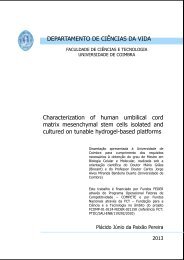Regulation of Apoptosis and Differentiation by p53 in Human ...
Regulation of Apoptosis and Differentiation by p53 in Human ...
Regulation of Apoptosis and Differentiation by p53 in Human ...
Create successful ePaper yourself
Turn your PDF publications into a flip-book with our unique Google optimized e-Paper software.
TABLE OF CONTENTS<br />
ABBREVIATIONS<br />
LIST OF PUBLICATIONS<br />
ABSTRACT/RESUMO<br />
XII<br />
XIV<br />
XV/XVII<br />
CHAPTER 1 1<br />
Introduction<br />
1.1- HUMAN EMBRYONIC STEM CELLS 3<br />
1.1.1- Criteria to def<strong>in</strong>e an embryonic stem cell 5<br />
1.1.2- Stem cell markers 5<br />
1.1.3- Culture methods for hESC propagation: advantages <strong>and</strong> limitations 7<br />
1.1.4- Ma<strong>in</strong>tenance factors <strong>of</strong> self-renewal <strong>and</strong> pluripotency 9<br />
1.1.4.1- LIF 9<br />
1.1.4.2- Fibroblast growth factor-2 (FGF-2) 10<br />
1.1.4.3- Transform<strong>in</strong>g growth factor β pathway 10<br />
1.1.4.4- Mouse embryonic fibrobasts secreted factors 11<br />
1.1.4.51- Other factors 11<br />
1.1.5- Strategies to improve clonal survival 12<br />
1.1.6- Cell cycle <strong>of</strong> hESC 12<br />
1.1.7- Epigenetics 13<br />
1.1.8- hESC signature <strong>and</strong> gene expression pr<strong>of</strong>il<strong>in</strong>g 13<br />
1.1.9- International Stem Cell Initiative: an attempt to compare 14<br />
different hESC cell l<strong>in</strong>es<br />
1.1.10- In vitro <strong>Differentiation</strong> <strong>of</strong> hESC 15<br />
1.2- GENETIC STABILITY: HESC AS A MODEL 18<br />
1.3- APOPTOSIS 21<br />
1.3.1- <strong>Apoptosis</strong> <strong>in</strong> development <strong>and</strong> homeostasis 21<br />
1.3.2- <strong>Apoptosis</strong> <strong>in</strong> ESC 22<br />
1.3.3- Major molecular regulators <strong>of</strong> apoptosis 23<br />
1.3.3.1- Bcl2 family 23<br />
1.3.3.2- Caspases 24<br />
1.3.4- Biochemistry <strong>of</strong> apoptosis 25<br />
1.3.3- Apoptotic pathways 25<br />
1.3.3.1- The Extr<strong>in</strong>sic Pathway 25<br />
1.3.3.2- The Intr<strong>in</strong>sic Pathway 25<br />
1.4- TUMOUR SUPPRESSOR P53 27<br />
1.4.1- <strong>p53</strong> knockout mice 28<br />
1.4.2- <strong>p53</strong> <strong>in</strong> apoptosis 28<br />
1.4.3- <strong>p53</strong> family <strong>and</strong> differentiation 30<br />
1.4.4- Role <strong>of</strong> <strong>p53</strong> <strong>in</strong> hESC 31<br />
1.5- RNA INTERFERENCE: SHRNA AND LENTIVIRUS 32<br />
1.5.1- Mechanism <strong>of</strong> RNAi 32<br />
1.5.2- Tool to study gene function 33<br />
1.6- AIMS AND HYPOTHESIS 35<br />
CHAPTER 2 37<br />
Material <strong>and</strong> Methods<br />
Section 2.1- Cell Culture Methods 40<br />
2.1.1- Commonly Used Tissue Culture Solutions, Reagents <strong>and</strong> Materials 40<br />
2.1.1.1- Growth factors 40<br />
2.1.1.2- Extracellular matrices 41<br />
2.1.1.3- Enzymes <strong>and</strong> dissociation solutions 41<br />
2.1.1.4- Miscellaneous Culture Components, Solutions <strong>and</strong> Material 42<br />
2.1.1.5- Medium solutions 43<br />
- ix -
















